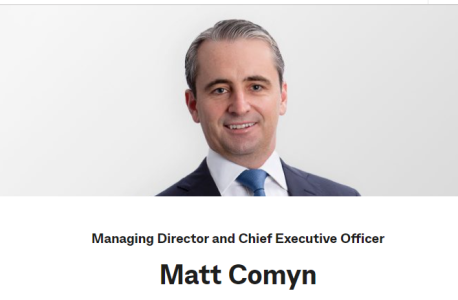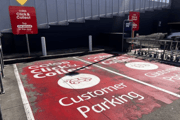Did you know handling cash is costing you an extra $40? CommBank boss reveals reason why
As our world continues to become digitalised by the day, with many of us able to do almost anything with the click of a button, the use of physical currency has reportedly declined.
Still, many prefer to carry around cash as not everyone is comfortable with online transactions or has access to the internet all the time.
However, it seems that keeping cash comes with its own cost.
This is according to Chief Executive Matt Comyn of Commonwealth Bank of Australia (CBA), who claimed that every customer is losing $40 per year by keeping cash.
The executive joined the CEOs of Australia and New Zealand Banking Group Limited (ANZ), National Australia Bank (NAB), and Westpac in a Senate inquiry into regional bank closures at Parliament House in Canberra last Wednesday, September 20.
The inquiry focused on the debate about the country’s move to a cashless society.
Mr Comyn argued that the costs of running 728 CommBank branches, which amount to $1 billion a year, to sell loans and manage cash transactions were becoming unsustainable since the demand had reduced.
‘Transporting and making cash available around our vast country involves the considerable expense of logistics and security,’ Mr Comyn said in the hearing.
‘We estimate that continuing to support distribution and availability of cash costs CBA approximately $400 million each year—which works out to roughly $40 for every one of our 10 million customers. Many of our customers don’t use cash though—and these customers cross-subsidise those that do,’ he explained.
It was reported that the CBA network had seen a decline in cash transactions in recent years.
‘Five years ago, 43 per cent of all point of sale transactions were cash,’ he shared.
‘Today, the figure is around 15 per cent. And yet every week customers transact more than $18 billion through the CommBank app—an increase of 64 per cent in just two years,’ he added.
However, Mr Comyn also stressed that CommBank has no plans to remove cash altogether, unlike Macquarie Bank.
‘We certainly have no plans to remove cash distribution or the provision of cash in Australia,’ he assured. ‘I don‘t think that’s feasible, and I don’t think that would be desirable, certainly in the foreseeable future.’
It was recently revealed that Macquarie Bank plans to phase out cash, cheque and phone payment services starting in January 2024. You can learn more about that story here.
The other CEOs also gave evidence about the dominance of digital transactions.
Westpac CEO Peter King stated that 96 per cent of customers’ transactions are now digital, while NAB boss Ross McEwan claimed theirs was 93 per cent.
Meanwhile, ANZ CEO claimed that more than 90 per cent of their customers aged over 65 ‘use at least one self-service option to do their banking, such as our ANZ app, internet banking or ATMs’.
‘While most customers prefer digital channels for many of their transactions, branches continue to be important,’ Mr Elliot emphasised.
Due to the Senate inquiry, CBA has paused all their regional bank closures until 2026.
‘As time goes on, it becomes unsustainable to invest substantial resources keeping expensive services that fewer and fewer customers use,’ Mr Comyn shared.
He also urged rural and regional customers to bank with CBA, saying: ‘Our decision to pause rural bank closures is predicated on customers and communities valuing our decision to stay.’
‘So for other local councils, small businesses, farmers, homeowners and regional areas, if you value CBA supporting your communities, we will be delighted to serve you.’
The Financial Sector Union estimated that more than 1,600 bank branches were closed nationwide in the five years to June 2022, with a disproportionate number located in regional and rural areas.
Without government intervention, it seems like the trend will continue—especially when the customer demand switches to online banking.
Richard Holden, Professor of Economics at the University of New South Wales (UNSW) Business School, said: ‘I’d say we’ll be functionally cashless by the end of 2025—it’ll just be a complete rarity.’
‘But unless the government gets involved to accelerate the process, I think we’ll be actually cashless by 2030,’ he continued.

Members, what’s your take on this story? Share your insights in the comments below!
Still, many prefer to carry around cash as not everyone is comfortable with online transactions or has access to the internet all the time.
However, it seems that keeping cash comes with its own cost.
This is according to Chief Executive Matt Comyn of Commonwealth Bank of Australia (CBA), who claimed that every customer is losing $40 per year by keeping cash.
The executive joined the CEOs of Australia and New Zealand Banking Group Limited (ANZ), National Australia Bank (NAB), and Westpac in a Senate inquiry into regional bank closures at Parliament House in Canberra last Wednesday, September 20.
The inquiry focused on the debate about the country’s move to a cashless society.
Mr Comyn argued that the costs of running 728 CommBank branches, which amount to $1 billion a year, to sell loans and manage cash transactions were becoming unsustainable since the demand had reduced.
‘Transporting and making cash available around our vast country involves the considerable expense of logistics and security,’ Mr Comyn said in the hearing.
‘We estimate that continuing to support distribution and availability of cash costs CBA approximately $400 million each year—which works out to roughly $40 for every one of our 10 million customers. Many of our customers don’t use cash though—and these customers cross-subsidise those that do,’ he explained.
It was reported that the CBA network had seen a decline in cash transactions in recent years.
‘Five years ago, 43 per cent of all point of sale transactions were cash,’ he shared.
‘Today, the figure is around 15 per cent. And yet every week customers transact more than $18 billion through the CommBank app—an increase of 64 per cent in just two years,’ he added.
However, Mr Comyn also stressed that CommBank has no plans to remove cash altogether, unlike Macquarie Bank.
‘We certainly have no plans to remove cash distribution or the provision of cash in Australia,’ he assured. ‘I don‘t think that’s feasible, and I don’t think that would be desirable, certainly in the foreseeable future.’
It was recently revealed that Macquarie Bank plans to phase out cash, cheque and phone payment services starting in January 2024. You can learn more about that story here.
The other CEOs also gave evidence about the dominance of digital transactions.
Westpac CEO Peter King stated that 96 per cent of customers’ transactions are now digital, while NAB boss Ross McEwan claimed theirs was 93 per cent.
Meanwhile, ANZ CEO claimed that more than 90 per cent of their customers aged over 65 ‘use at least one self-service option to do their banking, such as our ANZ app, internet banking or ATMs’.
‘While most customers prefer digital channels for many of their transactions, branches continue to be important,’ Mr Elliot emphasised.
Due to the Senate inquiry, CBA has paused all their regional bank closures until 2026.
‘As time goes on, it becomes unsustainable to invest substantial resources keeping expensive services that fewer and fewer customers use,’ Mr Comyn shared.
He also urged rural and regional customers to bank with CBA, saying: ‘Our decision to pause rural bank closures is predicated on customers and communities valuing our decision to stay.’
‘So for other local councils, small businesses, farmers, homeowners and regional areas, if you value CBA supporting your communities, we will be delighted to serve you.’
The Financial Sector Union estimated that more than 1,600 bank branches were closed nationwide in the five years to June 2022, with a disproportionate number located in regional and rural areas.
Without government intervention, it seems like the trend will continue—especially when the customer demand switches to online banking.
Richard Holden, Professor of Economics at the University of New South Wales (UNSW) Business School, said: ‘I’d say we’ll be functionally cashless by the end of 2025—it’ll just be a complete rarity.’
‘But unless the government gets involved to accelerate the process, I think we’ll be actually cashless by 2030,’ he continued.
Key Takeaways
- Commonwealth Bank of Australia’s (CBA) Chief Executive, Matt Comyn, told a Senate inquiry that keeping cash costs every customer around $40 annually.
- He argued the cost of running branches and managing cash transactions is becoming increasingly unsustainable as customer demand diminishes.
- Cash transactions across the CommBank network have decreased in recent years from 43 per cent to 15 per cent.
- CommBank confirmed it has no plans to remove cash distribution or provision in Australia despite increased digital transactions.
- According to estimates from the Financial Sector Union, over 1,600 bank branches were closed across Australia in the five years leading to June 2022, with a disproportionate number located in regional and rural Australia.
Members, what’s your take on this story? Share your insights in the comments below!








